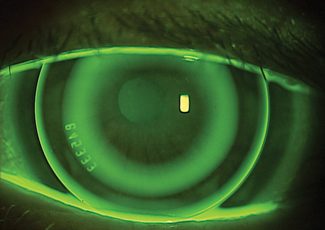 |
| When offering orthokeratology, opt for a 5mm back optic surface design in low myopes but a larger diameter for refractions above -2.5D. Photo: Robert Ensley, OD, and Heidi Miller, OD. Click image to enlarge. |
Myopia prevalence is rapidly growing, specifically in children between the ages of eight and 11, who often experience relatively fast axial lengthening. In a new study, researchers compared axial elongation in this age group wearing orthokeratology (ortho-K) lenses with different back optic zone diameters (BOZD), as well as defocus incorporated soft contact (DISC) lenses and single-vision soft lenses. DISC lenses use a concentric ring design comprising a central correction zone and a series of outer zones extending toward the periphery that alternate between defocusing (+2.50D addition) and correction. The design differs from commercially available dual-focus designs on the market but is similar in principle.
The researchers found that both ortho-K options and the DISC lenses showed slower axial elongation than the single vision soft lens group, with one-year elongation lower in the ortho-K group with a 5mm optic zone vs. the 6.2mm optic zone group.
A total of 122 children with spherical equivalent refraction (SER) between -1D and -4D were enrolled and randomly assigned to four groups: 5mm ortho-K, 6.2mm ortho-K, DISC lenses and single-vision lenses. Children in each group were further divided into subgroups stratified by the average baseline SER: low myopes (-1D to -2.5D) and moderate myopes (-2.5D and over). Axial length was measured at baseline and after one year.
All three treatment groups (5mm and 6.2mm ortho-K, plus DISC lens wearers) showed significantly slower axial elongation within 12 months when compared with single-vision soft lenses, and showed axial growth reduction efficacies of 56%, 28% and 47%, respectively. Axial elongation was significantly slowed down more in the 5mm group than in the 6.2mm group, corroborating previous studies, the authors noted in their article on the research.
For children with SER less than -2.5D, fitting with 5mm ortho-K lenses and DISC lenses yielded better myopia control efficacy compared to the other two groups, though 6.2mm back optic zone ortho-K lenses “were more suitable for children with higher degrees of myopia (higher than -2.5D),” they wrote.
These findings indicate that each intervention has its own advantages for a given population. For example, because of the relatively high control efficacies of 5mm ortho-K and DISC lenses, these may serve as a potential first recommendation for myopia control in eight to 11-year-old children with myopia.
The proportion of slow progressors in the 5mm ortho-K group was 42%, which was higher than that in the 6.2mm group (23%) and the DISC group (29%).
Recent orthokeratology lens designs have aimed to decrease the treatment zone size and bring the mid-peripheral defocus ring closer to the pupil, according to previous studies. The researchers explained in their paper that the 5mm ortho-K lenses “produced a smaller treatment zone size and meanwhile formed a larger percentage of defocus zone within the pupil area in the cornea” than 6.2mm lenses, indicating that a smaller treatment size “may help the peripheral retina receive more myopic defocus signals.” This could partly explain why the 5mm BOZD ortho-K lenses were more effective in slowing AL elongation among eight to 11-year-old children than 6.2mm version, they speculated.
“Based on our findings, clinicians may choose appropriate lenses for children with myopia to achieve ideal myopia control effects,” the authors concluded.
| Li N, Lin W, Liang R, et al. Comparison of two different orthokeratology lenses and defocus incorporated soft contact (DISC) lens in controlling myopia progression. Eye and Vision. October 7, 2023. [Epub ahead of print.] |

